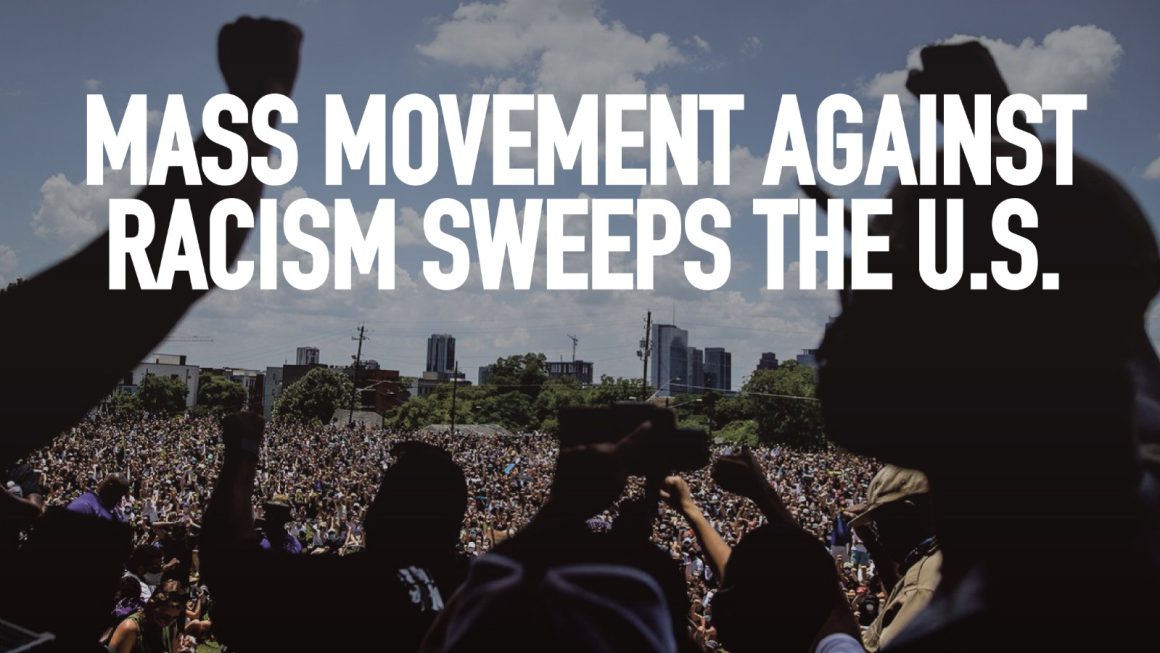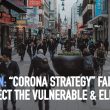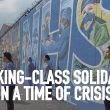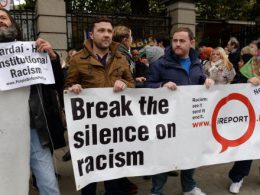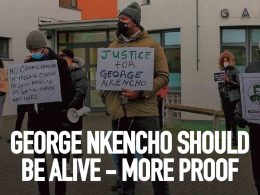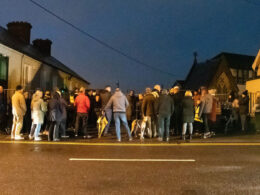By Keely Mullen, Socialist Alternative (our sister organisation in the US)
At 8:25 pm on May 25 George Floyd stopped breathing. Moments later his pulse stopped. It was two minutes before Minneapolis Police Officer Derek Chauvin removed his knee from Floyd’s neck. Less than an hour later, he was pronounced dead.
On the day of George Floyd’s death, we had been on lockdown for more than two and a half months. Millions of Americans had lost loved ones to COVID-19, and were forced in many cases to grieve in complete isolation. Tens of millions had lost their jobs and many more lost hours or pay. June rent was fast approaching and again families were weighing up if they could pay rent and buy groceries, or if one would have to go.
All of this has disproportionately affected the black working class. Black people are three times as likely to get COVID-19 compared to white people. Millions of black workers have been either furloughed or laid off and the unemployment rate for black people is the highest of any demographic.
It is in this context, a system in complete freefall, that the death of George Floyd ignited the most extensive protest movement in the U.S. in 50 years.
#Justice4GeorgeFloyd
Beginning in Minneapolis the night George Floyd was murdered, mass protests and occupations have overtaken the U.S. This marks a new and far more developed phase in the Black Lives Matter movement.
There have been demonstrations in every single state, with more demonstrations overall than the Women’s Marches in January 2017 which totaled more than 650. Far from being limited to big cities or Northern states, there have been over 100 protests across the Southern U.S. This has culminated in mass demonstrations on Saturday with hundreds of thousands in the streets of Washington DC and hundreds of thousands in cities across the country.
These protests are buzzing with energetic rage. They have been led mostly by black youth, but the crowds are notably multi racial. Young people of all races see this fight as theirs as well. Tens of thousands of mostly young people have been out in city after city with a simple overarching demand: no more police killings of innocent black people and an end to racist police brutality generally!
Unlike during the Black Lives Matter movement of 2014-2015, this movement has taken on the character of an all out rebellion and occupation in a series of cities.
In Minneapolis, protesters have turned the spot of George Floyd’s death into the headquarters for the movement. There is now a permanent encampment of the entire block surrounding the site of George Floyd’s murder.
Similarly, in Brooklyn, the blocks surrounding the Barclay’s Center are a near constant home to demonstrators. Almost like a shift change, children and families march during the day while teenagers and young adults replace them at night.
Trump and “Law and Order”
The transformation of these protests into a broader rebellion in some cities can be, in part, credited to the brutal response of the police to early demonstrations. They repeatedly used tear gas, rubber bullets, batons to the face, and – in a handful of instances – outright driving into crowds, against peaceful protests.
Socialist Alternative City Councillor Kshama Sawant has introduced legislation into the Seattle City Council to ban the use of chemical weapons (tear gas, pepper spray, mace), rubber bullets/blast balls/bean bags, water cannons, sonic weapons. This demand has since gone semi-viral and shows the important role socialist elected officials can play.
As brutal as the police repression has been, it doesn’t hold a candle to the brutality Trump wishes would rain down on demonstrators. He has urged governors to “dominate” protestors and has stated, “when the looting starts, the shooting starts.” He sent the U.S. military into Washington DC and has threatened to further deploy troops to other cities to put down the movement. He instructed police and the National Guard to teargas a peaceful protest outside the White House in order to clear a path for his photo-op holding a bible at St. John’s Church.
Trump has not found broad support for his authoritarian threats among the American public or even within his own administration, with high ranking military officials opposing the use of the military. Currently, 62% of Americans view the protests as legitimate. Even more surprising to the establishment, 54% of Americans believe that the burning down the 3rd precinct police station in Minneapolis was legitimate.
Trump’s approach, as well as the violent response from police to the protests, has only served to inflame the situation. He is trying to rebrand himself as the “law and order president” with his brutal response. He seems to want to hark back to Richard Nixon, who won the election in 1968 and ran on the same platform of “law and order”. But the context is completely different. In 1968, Nixon was the challenger while Lyndon Johnson and the Democrats were presiding over the debacle in Vietnam and massive civil unrest. Politically, Trump’s approach has benefited Biden who is firmly in the lead in national polls.
Democrats Exposed
On a national level, the Democratic Party has issued mealy-mouthed statements of support for the movement. However at the same time, Democratic mayors and governors across the country are imposing curfews, approving massive spending on the police while cutting social services, and outright denying the violence of their own police forces.
Scandalously many Democratic mayors and governors echoed Trump and Attorney General Barr’s narrative that confrontations with the police and looting were the work of “outside agitators.” Trump banged on about anarchists like Antifa, at one point even saying he would declare it a “terrorist organization.” The Democrats, particularly in Minneapolis, spread fear and misinformation about a wave of white supremacists coming in to disrupt the demonstrations. There have been almost no facts brought forward to support these narratives which were meant to direct attention away from police violence and justify further repression.
The New York Times editorial board on Friday released a scathing op-ed detailing the dramatic failure of New York Mayor Bill DeBlasio, who ran in 2014 saying he would reform policing, and Governor Andrew Cuomo to meet the needs of this moment.
They wrote: “What pressing responsibilities have so occupied these two officials that they do not have the time to make sure the safety of New Yorkers is protected and the rights of New Yorkers are respected? How is it possible that after so many reports of police misconduct, they still can’t be bothered to supervise the police?”
This reflects divisions in the establishment with a section of officials beginning to push for more serious reforms to policing. In New York, the Manhattan and Brooklyn DAs have said they would not prosecute the many hundreds arrested for “unlawful assembly” and “disorderly conduct”.
In Seattle, there is a tremendous mood to drive Democratic Mayor Jenny Durkan out of office for her failure to reign in police officers terrorizing protestors. Kshama Sawant has joined this call and officially called for Durkan’s resignation.
Some City Councilmembers in Minneapolis have made bold promises to abolish the police. Undoubtedly there will be reforms to policing in reaction to the pressure from the movement. Yet in a world where eight billionaire men own as much wealth as the poorest half of the world population and 40 million Americans are currently unemployed, the state will always rely on some type of repressive force to maintain order. Socialists argue that a world without police can only be built on a foundation of guaranteed jobs, housing, healthcare, schools, and democratic control of society’s resources.
Unfortunately, throughout this rebellion Bernie Sanders has been largely absent. This is just further confirmation of the terrible consequences of his complete capitulation to the Democratic Party establishment. Had he stayed in the race he could have helped use his campaign to help push for decisive change.
This movement has no doubt weakened the Democratic Party’s authority as key officials have been seen to whip up fear and enable and excuse further escalations of police violence. But another section is working hard to co opt the movement.
One exception to the overall picture with the Democrats is the strengthening of Biden’s campaign. But this is primarily due to the wide revulsion to Trump’s dangerous authoritarianism. While Biden has come out of his bunker a bit to take Trump on, it was only two weeks ago that he scandalously said “You ain’t black” if you support Trump.
Organising the Struggle
This movement has already won the firing, arrest and indictment of all four officers involved in George Floyd’s murder. This was far from inevitable and was brought about by the resilience of demonstrators across the country – but especially in Minneapolis.
We need a sense of urgency in building on this momentum. Here are next steps Socialist Alternative proposes the movement take:
Demands: We need concrete demands both nationally and locally. Calls to “defund” and restructure police departments around the country have gained steam, with some cities like LA even taking steps to reduce police funding. Cities across the country spend inordinate amounts on the police. Kshama Sawant has called for cutting the Seattle police budget in half. Socialist Alternative supports redirecting significant portions of the police budget toward housing, education, and healthcare.
We also need a purge of police forces across the country. Any officer with a history of racism, sexism, or violence should be immediately fired. This should be carried out by democratically accountable community oversight boards.
Our demands must reflect the scale of the crisis working people face. While the starting point for these demands is no doubt specific to fighting racist police brutality, we should not stop there. The growing cost of rent, consistently low wages, and our completely inadequate healthcare system all disproportionately impact black Americans. We are in the middle of a pandemic and at the beginning stages of a global economic depression.
The labor movement should get involved: Fighting racism demands the participation of the entire working class. The motto of the labor movement is, “An injury to one is an injury to all.” Unions need to urgently organize their participation in the protests. This can take the form of nine minute solidarity strikes to mark the nine minutes Derek Chauvin had his knee on George Floyd’s neck. It can also include organizing defense of the demonstrations against police violence, transforming union halls into depots for protestors to get supplies and PPE, and forming contingents to join marches and protests daily. In Minneapolis, Socialist Alternative has called for preparing a one day local general strike in solidarity with the movement and to demand an end to the National Guard occupation of the city.
Structures: The movement in every city needs structures so we can discuss next steps. There should be, to start, daily open-air meetings where we can touch base about plans for the day and troubleshoot. If the movement were to continue at this pace, these meetings would need to be transformed into formal organizing bodies with representatives from participating organizations. We also need secure online forums to communicate rapidly.
Defense: We need a designated, multiracial defense team at every demonstration who can protect against anti-social and criminal elements looking to take advantage of the situation. This is not because of any moral concern to protect private property, but to prevent people from employing tactics which could undermine wider support for the movement.
“An Injury to One is an Injury to All”
Already an important section of the labor movement has put their stamp on this rebellion. A shining example of this is the socialist led bus drivers union in Minneapolis who – on the very first night of demonstrations – refused to transport protestors to jail. This quickly spread to New York City and Washington D.C. (among other cities) where transit workers have taken a similar stand.
On the 11th day of demonstrations, nurses across the country took a knee on the lawns of their hospitals in solidarity with Black Lives Matter. The backwards priorities of our system have been rubbed in the faces of these nurses who have been forced to work through a pandemic wearing garbage bags while outside their window police march through the streets in full riot gear.
As the first week of protests ended, grocery workers in Minneapolis began organizing walkouts and work stoppages in support of the movement. On June 5th, a Minneapolis grocery worker and Socialist Alternative member organized her entire shift to walk off the job. They marched to the front of their store chanting and holding signs for 8 minutes and 45 seconds before returning to work. In addition, Socialist Alternative members who work at the post office in Minneapolis spearheaded a solidarity rally with 60 postal workers. They marched from their burned out worksite to the occupation, boldly declaring that a building can always be rebuilt, but we can’t rebuild the life of someone murdered by the police.
As marches take major streets and highways across the country, some of the loudest eruptions of cheers from demonstrators are sparked by a simple act of solidarity from other ordinary working people. In New York, every time a bus driver, taxi driver, or delivery driver honks their horn in support of the protests, the crowd audibly loses itself with pride.
The potential for organized solidarity from the wider labor movement is immense. However, the existing leadership of most major unions has – once again – been found completely wanting. In an AFL-CIO hosted press conference, the leaders of some of the countries biggest unions had little more to say than, “racism is bad, Trump is bad, please vote.” This is completely unsatisfactory. The needs of the movement cannot wait until November. If the existing labor leadership is not equipped to fully mobilize their membership in the battle against racism, then we need new leadership. We need the most fighting, willing elements in the labor movement to organize to reclaim the unions as real organizations of struggle.
Need for Effective Tactics
Protests in some cities have temporarily burst into riot mode, with police cars (and entire police precincts in the case of Minneapolis) burned down. A very small minority of protestors have taken up anti-social behavior like looting. In some cases this looting is more clearly driven by poverty, with reports of parents taking food and diapers. However in other cases it is people opportunistically taking advantage of the chaos.
The rage that sits behind rioting is not just understandable, it’s positive. We should be angry. There’s a lot to be angry about. However, we have to be strategic about how that rage is channeled. In the absence of democratic structures for the movement to debate the way forward, people will employ a whole range of tactics – some effective and some not.
Building this rebellion into an ongoing mass movement capable of winning lasting change will require that democratic structures are built locally and nationally to coordinate strategy and tactics for the movement. Tactics should be decided with an eye to bring wider sections of the working class into the struggle.
“The Whole Damn System is Guilty As Hell”
Across the country right now people are rushing into the streets enraged by rampant racism in our society. However, it is clear from a mile away that the rage goes far deeper. It hangs like a cloud over the demonstrations. For many protesters demanding justice for George Floyd, it is obvious that our entire economic and political system is broken.
While the Black Lives Matter demonstrations in 2014-2015 gave expression to a sense, particularly among black youth, that the whole system was rigged against them — this has only been broadened as millions are sinking further into poverty.
The sharpening desire for serious change on all fronts needed cannot be separated from the broader conditions we face. Young and working class people of all races are losing people they love to a virus that could’ve been contained, watching their debt mount, their wages cut, their jobs lost, and are wondering: is there a way forward?
The answer is a resounding yes, but we have to fight for it. We have to fight in the here and now for a complete overhaul of policing, for safe and stable housing and healthcare, for jobs programs, for fully funded education and social services.
However we also cannot see these reforms as an end goal. Our project must be to create a multi-racial movement of the working class to put an end to the system of capitalism – the system that forms the base of our society.
Our political institutions – including the police – exist to defend the interests of the capitalist ruling class, not working people. If we are going to truly overcome centuries of anti-black racism and all other forms of oppression, we need an entirely new system. One that does not reward division, cutthroat competition, and the hoarding of resources but rewards genuine solidarity, collaboration, and a redistribution of society’s wealth, a socialist society.





